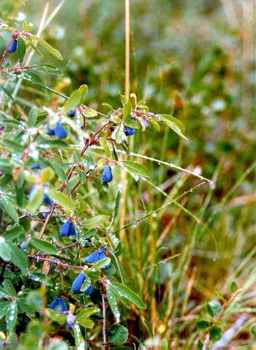Relatives
Lonicera altaica Pall. - Altai honeysuckle
Taxonomic position.
Family Caprifoliaceae Juss., genus Lonicera L.Synonyms.
L. caerulea subsp. altaica (Pall.) Gladkova, L. caerulea var. altaica Fisch. ex Sweet., L. altaica subsp. Subarctica (Pojark.) Worosch.Morphology and biology.
Deciduous shrub that grows up to 2.5 m tall. Old branches have brownish grey, often exfoliating bark. Young shoots are usually bare or, less frequently, sparsely covered with short, squarrose, bristle-like hairs. Leaves vary in shape from oblong-ovate to elliptical or broadly lanceolate, sharp or somewhat blunted at the top; 2.5-4.5 cm long and 0.5-3 cm wide; on sterile shoots up to 7 cm long and 3.3 cm wide; bare or covered with sparse, long cilia at the edges. Flowers are set in pairs in the axils of lower leaves. Corolla is tubular funnel-shaped, yellowish white. Stamens are equal in length to the corolla or slightly longer. Compound fruit are elongated, 7-14 mm long, dark blue with glaucous bloom, edible, tasting sour-sweet with bitter flavor. Blossoms at the end of May; berries ripen in late June and early July. Ripe fruit remains on the plants until late autumn. Entomophilous. 2n=36.Distribution.
Occurs in Western Siberia (Altai), Eastern Siberia (Sayan Mountains, northwestern part of Dauria), Kazakhstan (Altai, Saur), Northwestern China, and Western Mongolia.Ecology.
Mesoxerophyte. It tolerates shade. Occurs as isolated plants or in small groups in the undergrowth of larch, cedar-larch and mixed forests; quite common in stony places and rocks. In open sites, it sometimes forms extensive thickets. In the mountains, it spreads from the forest zone to the alpine zone, as a rule, at altitudes of over 1,000 m above sea level.Utilization and economic value.
Used for food, either fresh or processed (juices and jams). Used in breeding practice due to such traits as large fruit size, high yield, non-shedding during ripening, good transportability of berries and winter hardiness. The extract of its fruit is a natural food pigment of red color that has showed good results in trials and has proved promising for the confectionary industry. Also used as nectariferous and ornamental plant. Suitable for winds belts in fields. Medicinal use includes homoeopathy, Tibetan and folk medicine).Reference citations:
Plekhanova M.N. 1998. Blue honeysuckle in garden and nursery. Leningrad: Vavilov Institute of Plant Industry, 66 p.Plekhanova M.N., Solovyeva L.V., Mochalova O.V. 1992. Chromosome numbers and area of distribution of Lonicera subsect. Caeruleae (Caprifoliaceae). Botanical Journal, 7(9): 1-11.
Sokolov P.D., ed. 1990. Plant resources of the USSR: Flowering plants, their chemical composition and utilization. Caprifoliaceae-Plantaginaceae families. Leningrad: Nauka, 7 p.


